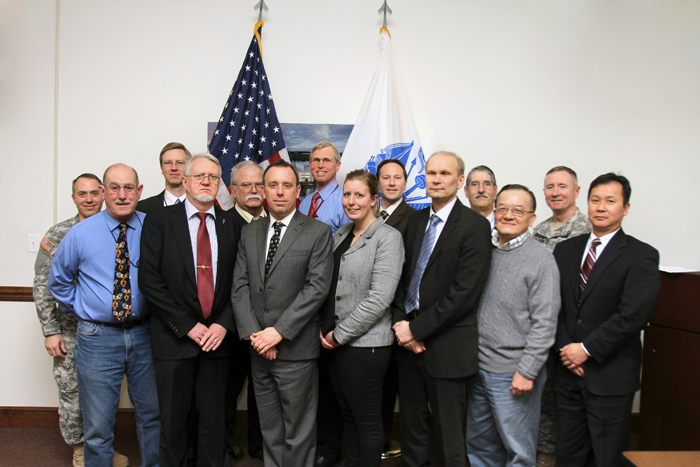Swedish Defense Scientists Visit ECBC and USAMRICD

Representatives of the Swedish Defense Research Agency (FOI) met with leaders and scientists at the U.S. Army Edgewood Chemical Biological Center and the U.S. Army Medical Research Institute of Chemical Defense to discuss common research interests at Aberdeen Proving Ground, Md., Feb. 12.
FOI representatives Dr. Anders Bucht, research director, Göran Olofsson, director of engineering, and senior scientists Dr. Lina Thors and Dr. Fredrik Ekström visited APG to learn more about the use of Raman spectroscopy for defense research applications and the identification of better reactivators of the enzyme acetylcholinesterase (AChe) to improve protection against chemical nerve agents.
Raman spectroscopy has a variety of applications in defense research and development. The technology relies upon a scattering-based phenomenon that utilizes a single laser source. The laser light interacts with the molecules shifting the wavelength based on the molecular structure of the molecules, which in turn generates a spectral signature.
USAMRICD uses the Raman to determine the penetration of chemical warfare agents through skin and evaluate the effectiveness of medical decontamination. Dr. Ernest Braue, USAMRICD's deputy program advisor for decontamination, discussed his team's work using the Raman microspectroscopy to obtain real-time, non-invasive analytical data on the concentration of chemicals in the upper skin layers following exposure. He noted that the team is evaluating the effectiveness of reactive skin decontamination lotion, the personnel chemical agent decontaminant used by U.S. troops.
Thors presented data from FOI's research using human skin removed during cosmetic surgery. According to Thors, scientists place the skin specimens in an apparatus to measure permeability and chemical agent transport across the skin before and after decontamination.
ECBC researchers discussed their use of Raman spectroscopy for detection purposes. Dr. Augustus W. Fountain, ECBC senior research scientist for chemistry described using the technology to detect bulk explosives on surfaces and forensic detection and attribution of explosives and narcotics found on residual fingerprints. The Swedish contingent presented data on FOI's efforts with UV enhanced Raman to detect chemical warfare agent contamination on surfaces.
Another area of research currently being pursued by all three organizations is the identification of improved reactivators of biological enzymes to provide better protection against the toxic effects of chemical nerve agents.
ECBC scientist Jude Height and FOI representative Ekström presented information on cholinesterase research which focused on high resolution, direct measurements of the AChe binding sites, specifically the structural changes that occur as a result of chemical nerve agent poisoning. According to the presenters these measurements are then used in dynamic models which are expected to provide critical data for rational design of new, more effective cholinergic reactivators to protect soldiers in the future. Height also discussed the structural biochemistry of AChE and the design of new reactivators.
USAMRICD focused its reactivator discussion on medical neuroprotection. Nerve agent inhibition of the enzyme AChE in the brain can result in seizures and neuropathology, leading to incapacitation and death. According to USAMRICD researchers this makes identifying reactivators that work safely in the central nervous system particularly important.
Dr. Robert Kan, USAMRICD deputy program advisor for neuroprotectants, briefed a new research project to develop zebrafish larvae as an alternative animal model for high-throughput screening of reactivators in nerve agent biomedical research. Discussing FOI's approach to reactivators research, Thors discussed his agency's ex vivo lung organ model for studies of new reactivators and acetylcholine receptor antagonists.
Meeting participants agreed that the day's sessions helped to increase understanding of the missions and research efforts of the U.S. and Swedish organizations, and serve as a foundation for future coordination and collaboration in international chemical defense research.














